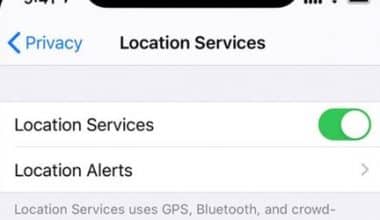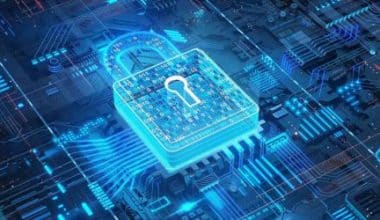The term encrypt originates from the Greek word Kryptos, meaning hidden or secret. Encryption means protecting your data from unauthorized users. You can encrypt your email and text to avoid other people from viewing it. Encryption uses a different algorithm to convert data into an unreadable form. These and all you need to know about encryption will be discussed in the text below.
What Is the Meaning of Encrypt?
Encrypt is the term that defines the procedure of converting data into an unrecognizable or encrypted form. Encryption is frequently used to secure sensitive data so that only those with permission can access it. This includes data transferred across wireless networks and the internet, as well as files and storage devices.
Anyone who tries to view an encrypted file will see it as scrambled. It has to be decrypted before it will be recognizable. Files that undergo encryption must be unlocked with a password. You can use file encryption programs like GnuPG or AxCrypt to encrypt a file, folder, or whole volume.
AES (Advanced Encryption Standard), DES (Data Encryption Standard), Blowfish, RSA, and DSA are some of the most popular encryption algorithms (Digital Signature Algorithms). While the majority of encryption techniques are adequate for protecting your personal data, it is better to choose a contemporary algorithm like AES with 256-bit encryption if security is crucial.
How Does Encryption works
Encryption works by converting “plaintext” into “ciphertext”. Algorithms are commonly used in cryptography to do this. An algorithm-generated password or a decryption key must be used to convert the data from encrypted to plaintext.
An unauthorized person cannot readily determine the proper string of characters using a computer by trying every possible combination, nor can they estimate which one is accurate because secure encryption techniques have such a vast number of cryptographic keys (known as a brute force attack). Encryption also protects data sent through wireless networks and the internet.
The decryption keys used in modern cryptography are substantially more complex, consisting of strings of hundreds or even thousands of computer-generated characters.
Types of Encryption
Symmetric and asymmetric encryption algorithms are the two most popular forms.
#1. Symmetric Encryption
In symmetric encryption, only one key is used for both encryption and decryption. It is commonly referred to as a shared key or private key algorithm. Data decoding is faster using symmetric key ciphers because they are less expensive to make and use fewer processing resources to encrypt and decrypt.
The disadvantage here is that any messages and data transferred between the parties can be decrypted if an unauthorized person obtains the key. Because of this, the shared key must be encrypted before being sent, creating a loop of reliance.
You should also make the password more complicated and challenging to decipher.
The level of security increases with the length of the key. An odd example of this type of encryption is AES 256. The use of 256 characters offers both complexity and security.
#2. Asymmetric Encryption
Asymmetric use public-key cryptography that encrypts and decrypts data using two different keys. One is a public key for encryption that all parties will have. The recipients of the second, private key are the only ones who are able to decrypt messages sent by anyone having the public key.
It is a straightforward encryption technique that employs two “Public Key” and “Private Key” keys that mathematically complement one another. The private key is used for decryption in this manner, whereas the public key is used for encryption. With the private key, only authorized recipients can decrypt the communication.
Since the public encryption key is frequently large—between 1,024 and 2,048 bits—asymmetric encryption is more expensive to manufacture and requires more processing power to decrypt. As a result, asymmetric encryption is frequently inappropriate for large data packets.
Uses Of Encrypt
There are four crucial tasks that encryption accomplishes:
- It keeps the data’s contents private and confidential.
- Integrity: It confirms the source of the data or message
- Authentication: It verifies that the message’s or data’s content hasn’t changed after transmission.
- Non-repudiation: This safeguard prevents the sender of data or messages from disputing its authenticity.
What Is Encrypt Example?
There are several examples you use to illustrate encryption even in our daily life. For instance, many WiFi networks are protected with WEP or the significantly more powerful WPA encryption. To join a secure Wi-Fi network, you must enter a password (and occasionally a username), but once you are connected, all data exchange between your device and the wireless router will be in encryption form.
Websites and software that transmit information details on bank account numbers and credit cards do so in encryption form. A lot of websites and other online services use SSL to encrypt data transmissions. The HTTPS protocol encrypts all data exchange between the web server and your browser.
Encrypt Email
Email encryption is the process of encrypting emails so that only the intended recipients can see the content. Email encryption also includes authentication.
Information disclosure can only be possible when using email. Although being kept in clear text and typically encrypt during transmission, most emails can still be read by email service providers and other third parties.
Many email platforms like Gmail and Outlook do not by default provide end-to-end encryption. Anyone other than the receivers listed in the email is able to read its contents using some tools at their disposal.
Email encryption may use public-key cryptography, in which users can each publish a public key that others can use to encrypt communications to them while maintaining a private key that they can use to decrypt such messages or to digitally encrypt and sign messages they send.
Email Protocol
There are currently two primary protocols for email encryption:
- Encrypting a message in transit (TLS)
- Email encryption that is end-to-end
#1. Transport Layer Secure (TLS):
Email service providers like Microsoft and Google utilize this encryption to protect emails as they travel from sender to recipient. It prevents reading emails after they have been sent but not before delivering them.
Before the introduction of TLS Protocols, it was usual for cybercriminals to get access to unencrypted emails while they were in transit. These assaults, also referred to as “man-in-the-middle” attacks, might be extremely harmful to enterprises.
Even while TLS offers excellent defense against these specific attacks, emails are only really secure while in transit. This implies that any emails or attachments would still be accessible to hackers who successfully infiltrate an email account through phishing or another method.
TLS encryption by itself is insufficient for protecting emails that include extremely sensitive information or emails used for business. Because of this, a lot of businesses are utilizing enterprise email encryption solutions that offer end-to-end encryption.
#2. End-end Encryption
In this case, the sender encrypts the email messages which can only be decrypted by the intended recipient on their device thanks to end-to-end encryption. Emails that are end-to-end encrypt are protected during the whole transmission process and are unreadable even by email servers. Cybercriminals will find it very challenging to corrupt sensitive data or attachments as a result.
Simply put, end-to-end encryption secures email by using public keys. The recipient’s public key is used by the sender to encrypt messages. With a private key, the recipient decrypts the communication.
PGP and S/MIME are the two methods that businesses can use to establish end-to-end encryption. These entail businesses manually setting up their email platforms to deliver encrypted emails.
Yet, these can be extremely challenging and complex to configure for enterprises of all sizes and frequently have their own security flaws.
How to Encrypt an Email
S/MIME is already integrated with the Gmail app, but both the sender and the recipient can only use it when it is turned on.
To switch on hosted S/MIME. You can enable this setting by following Google’s instructions for enabling S/MIME.
- Write your message in the usual manner.
- To the right of the recipient, click the lock icon.
- To modify the S/MIME settings or level of encryption, click “see information”.
Keep in mind these color codes when adjusting the encryption levels: - Green — It is using S/MIME encryption to safeguard the data, and only requires a private key to decrypt it.
- Gray — The email is TLS-secured (Transport Layer Security). This only functions if the sender and recipient are both TLS-capable.
- Red — There is no encryption security on the email.
How to Encrypt Text
There are numerous, intricate, and technological methods for sending encrypted text messages. The only thing you need to do is install one of the many apps that will do all the tedious work for you and begin sending messages. You can encrypt your text by using encryption tools like:
- CryptoForge
- Telegram
- Threema
- Signal
- Wire
AES Encryption
AES simply means Advanced Encryption Standard. The U.S. National Institute of Standards and Technology’s (NIST) Advanced Encryption Standard (AES), commonly referred to by its original name Rijndael (pronounced [rindael] in Dutch) is a specification for the encryption of electronic data that was created in 2001.
Two Belgium cryptographers, Joan Daemen, and Vincent Rijmen created the AES variation of the Rijndael block cipher and presented a proposal to NIST as part of the AES selection process.
A family of ciphers called Rijndael has various key and block sizes. NIST chose three Rijndael family members for AES, each having a 128-bit block size but three distinct key lengths: 128, 192, and 256 bits.
The American government has embraced AES. The Data Encryption Standard (DES), which was released in 1977, has been replaced by this one. The AES algorithm is a symmetric-key algorithm, which means that the data is encrypted and decrypted using the same key.
How Does AES Encryption Work?
Learning how AES transports data across various phases is the first step in comprehending how it functions. A 4×4 matrix carries the data in a single block since a single block is made up of 16 bytes, with one-byte stores in each cell.
It uses state arrays to describe the matrix. Similar to this, it multiplies the initial key by (n+1) keys, where n is the number of rounds in the encryption process. Hence, for a 128-bit key, the number of rounds is 16, and the total number of keys that will generate is 11 keys (10+1).
What Are the Features of AES?
- SP Network: Unlike the DES method, it operates on an SP network structure rather than a Feistel cipher structure.
- Key Expansion: It uses one key at the initial stage; afterward, it uses numerous keys in separate rounds.
- Byte Data: The AES encryption technique operates on bytes rather than bits of information. Hence, when encrypting data, it treats a 128-bit block size as 16 bytes.
- Key Length: How many rounds are required depends on how long the key is being used to encrypt the data. There are 10 rounds for a 128-bit key size, twelve rounds for a 192-bit key size, and fourteen rounds for a 256-bit key size.
Why Does Encrypt Mean?
Encrypt means converting data to an unreadable form to avoid a malicious attack.
How Do You Encrypt a File?
File encryption means protecting your data by encrypting it. Only someone with the right encryption key (such as a password) can decrypt it. File encryption is not available in Windows 10 Home. You can encrypt your file with these steps.
- Right-click (or press and hold) a file or folder and select Properties.
- Select the Advanced button and select the Encrypt contents to secure the data check box.
- Select OK to close the Advanced Attributes window, select Apply, and then select OK
- Choose the ‘encrypt the file and the parent folder’ option: Then, a pop-up will appear. If you want to encrypt the entire folder, choose the ‘encrypt the file and the parent folder’ option. Moreover, if you want to encrypt only the file, click on the ‘encrypt the file only’ option. Now, click on the OK button.
- Click the Cancel button: After performing these steps, you will get a notification on your screen as a backup option. Then click the Cancel button to stop this action.
- Moving on, if you want to have a backup/copy to retrieve the information, you can click on the pop-up that appeared for backup. Then click on the first option, “Back up now (recommended),” to get a backup.
What Happens If I Encrypt my Phone?
Encrypting the entire phone ensures that no data on the device is accessible by unauthorized users. For instance, If your phone was protected with an encryption PIN or password and lost or stolen, it would stop someone from accessing your data.
How Do I Encrypt WhatsApp Messages?
All message in WhatsApp uses end-to-end encryption. But if you want to create a backup for your files then follow the instructions:
- Open Settings.
- To backup end-to-end encrypted chats
- Select Chats > Chat Backup.
- Following the instructions to generate a password or key, tap Turn On.
- Selecting Create and wait for WhatsApp to create your end-to-end encrypted backup.
How Do I Encrypt my Phone?
- For iOS devices: Open Settings; select Face ID & Passcode; and then input your passcode. Then, check the bottom of the screen for the Data protection is enabled checkbox. Encryption is active if you can see it.
- Android devices: Choose Settings > Security > Encrypt Device and adhere to the prompts on the screen.
What Happens When You Encrypt?
The data on your device remains scrambled and unreadable. This implies that the data would be useless if someone removed the hard drive from your device and attempted to transfer it somewhere else.
Is WhatsApp Encrypted?
Whatsapp uses end-to-end encryption. Whatsapp keeps Calls and messages private. No one else, not even WhatsApp, can read or hear them. Yeah, by default, all chats on the site are encrypted. WhatsApp uses a Signal protocol-based end-to-end encryption technology.
In Conclusion,
Encrypting your data will help you to avoid theft or malicious attack however it can prove to be a disadvantage if you are not good at remembering passwords. All encryption uses passwords to encode and decode information. When picking a passcode, use something that you won’t forget in a hurry.
FAQs
Why do we encrypt?
To protect. In addition to enhancing the security of communication between client apps and servers, it helps safeguard sensitive data and private information. In short, if your data is encrypted, even if someone or something has access to it without your permission, they won’t be able to read it.
What does encoding mean?
Encoding is the process of using a certain code, such as letters, symbols, and numbers, to data in order to transform it into a cipher that is equal.
What is cipher?
A cipher is an algorithm for encrypting and decrypting data in the field of cryptology, which deals with the study of cryptographic methods.
Related Articles
- Discover 5 Compelling Reasons for Your Business to Employ a VPN
- Cloud Technology: Beginners Guide to Cloud Technology Solutions
- Advantages of VPN: Everything You Should Know!!
- CLOUD COMPUTING: Definition, Types, Pros, Cons & PDF (Detailed 2023 Guide)
- FILE ENCRYPTION: All You Need to Know
- TOP 20+ PENETRATION TESTING TOOLS 2023






